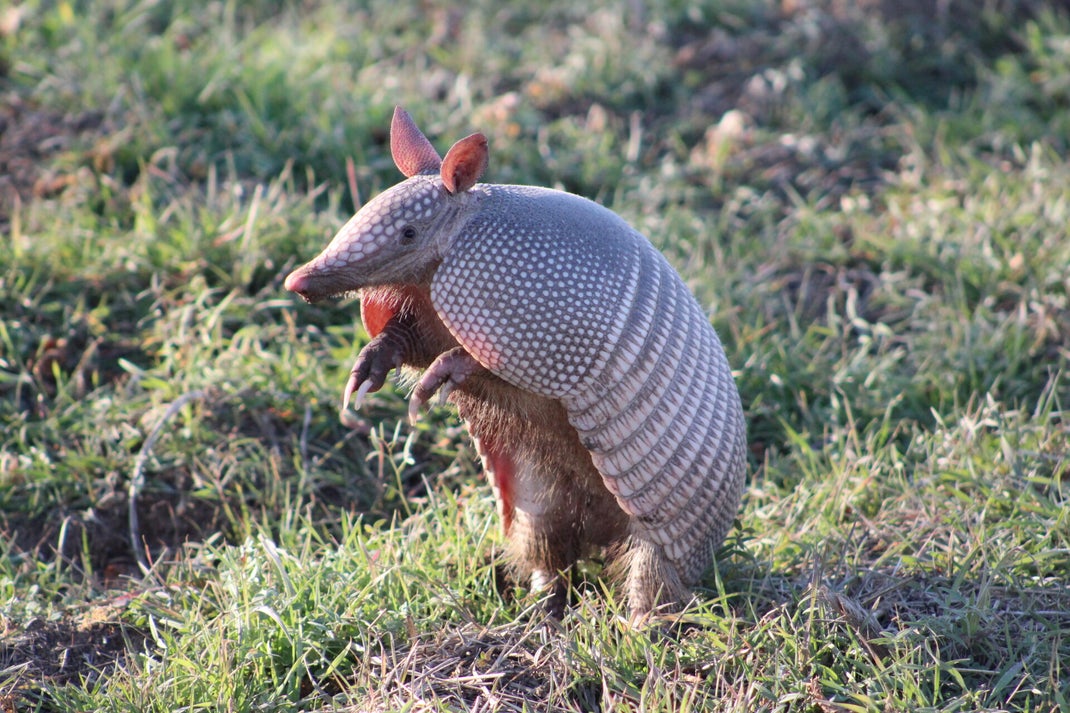Contribution from a Pulaski Countian. Edited by SPA Staff
It wasn’t that long ago that armadillos were a Deep South curiosity, more likely to be spotted near Gulf Coast highways than along a Kentucky fence line. But if you’ve recently seen one lumbering across a back road or turning up in a trail cam photo, you’re not imagining things. The nine-banded armadillo, once confined to places like Texas and Louisiana, has officially made itself at home in Southern Kentucky.
From Woodford to Jessamine County, sightings are up. Roadkill reports confirm it. And the reasons? Like many wildlife shifts these days, you can thank climate change, milder winters, and the species’ sheer adaptability. These tough-shelled mammals don’t mind woods, fields, or suburban lawns, anywhere the soil is soft enough to dig and the bugs are plentiful enough to snack on.
But this odd little invader brings more than just novelty.

Image by Alicia | Adobe Stock
What’s Under the Shell?
In 2024 researchers launched a study across central Kentucky to learn more about this creeping colonizer. Using roadkill samples, more than 30 in all, they hoped to track the armadillos’ spread and screen them for a lesser-known threat: leprosy, also known as Hansen’s disease.
Read more here: Armadillos migrating to Western KY; they may have leprosy | Lexington Herald Leader
Yes, you read that right.
Out of 22 tested animals, three carried Mycobacterium leprae, the same bacteria that causes leprosy in humans. That finding isn’t entirely shocking to public health experts; in states like Texas and Florida, armadillos are already considered natural hosts. In fact, DNA tests have matched bacterial strains found in armadillos to those found in people diagnosed with leprosy, suggesting that cross-species transmission is more than just a theory.
Should We Be Worried?
Let’s be clear: leprosy is extremely rare in the United States. The Centers for Disease Control and Prevention (CDC) logs about 150 to 200 cases per year nationwide, and the vast majority are treatable with antibiotics. But it’s also true that several recent cases have been reported in people with no overseas travel history, just local exposure to armadillos or the soil they frequent.
So, should Kentuckians panic? No. But awareness matters.
Direct contact, especially handling an armadillo, consuming its meat, or cleaning up after it, is where the real risk lies. Casual backyard sightings pose little to no danger. Still, if you're a gardener, hunter, or spend a lot of time outdoors, it doesn’t hurt to be cautious.
The good news is that we could not find any documented evidence of dogs naturally contracting leprosy. However, if your dog plays with, bites, or brings back a dead armadillo, you should:
- Use gloves if you must touch the carcass.
- Bathe your pet.
- Wash your hands thoroughly.
- Monitor for cuts or wounds on your dog's mouth, though risk remains very low.
- Keep your vet informed if your dog has had contact with wild animals.
As an interesting side note we learned during the research is that there is a dog specific leprosy (different from the one discussed here), but it is not known to be transmissible to humans. We have included the original article here for those interested: Can Dogs Get Leprosy from Armadillos?
Safety Tips from the Field
- Don’t touch wild armadillos, alive or dead—especially barehanded.
- Never eat armadillo meat (yes, some folks still do).
- Wear gloves when gardening in areas where armadillos are known to dig.
- Medical pros should consider Hansen’s disease in patients with unusual skin lesions or nerve symptoms, even if they've never left the U.S.
A Bigger Picture
The arrival of armadillos in Kentucky isn’t just about one animal. It’s part of a broader pattern of species migration tied to warming temperatures and changing ecosystems. As habitats shift, so do the boundaries between animals, people, and the pathogens we each carry.
Armadillos aren’t aggressive. They don’t carry rabies. But they do force us to reconsider how diseases once thought exotic are becoming surprisingly local.
So, if you spot one waddling across your pasture, or find one flattened along Highway 27, you’re witnessing a quiet biological migration in real time. Kentucky isn’t just bourbon, bluegrass, and barn cats anymore.
There’s a new critter in town. And it’s got a shell of a story!
---On the positive side, our carnivorous ground squirrels are not known to carry the plague like they do in western states.---
Centers for Disease Control and Prevention. (2024). Hansen’s Disease (Leprosy). U.S. Department of Health and Human Services.